人教高一英语单元教学目标及教学要求_5
高一英语工作计划安排(目标任务、主要措施)5篇

高一英语工作计划安排(目标任务、主要措施)5篇高一英语工作计划篇1一、教育教学指导思想树立新观念,钻研新大纲,探索新教法。
二、教学工作1、必修课。
本期教学课时仍然紧,教材内容多,知识覆盖面大,在上好教本的同时,要特别考虑拓展学上的课外知识,人文知识,加强课外阅读的补充和指导,具体方法如下:a)狠抓单元教学,突出单元教学重点。
把握好各个环节。
让学生不仅学习知识,而且得到能力的培养。
b)增强教改意识。
要整体提高学生的思想认识和文化品味。
要将“教法指导”转为“学法指导”,重视指导学生思维方法的学习,要引导并鼓励学生的创新意识。
相对淡化知识系统,强调运用语言的能力和语感能力的培养,重视积累,感悟和熏陶。
新教材中的“口语交际”要让学生充分活动,还要采用多种形式拓展学生的英语实践活动,努力提高学生学习英语的兴趣。
2、课内课外阅读。
a)教师指导阅读,教师除了课文中阅读材料,还要指导学生的课外阅读,备课时要对其内容,重难点,方式方法等都要作通盘考虑。
另外还要注意“教本”和“课外阅读”的相关延伸,即“课外阅读”和“教本”具体课文的相关衔接。
同时,教师还要对学生进行阅读策略方面的指导。
b)学生单元小结1)积累词语,对课文涉及的重要词语,要抄写、查字典解释重点记忆。
2、)阅读报刊文章写点评;3)每单元写一百字左右与课文内容相关的作文。
c)课堂交流,课堂内除了individualactivity,pairwork,groupwork,discussion,debate这些活动,还有课外的teamwork,dutyreport,这些材料都以书面形式和口头形式呈现,最后由教师收集作资料保存。
d)英语学习小组活动,每个小组每学期都有机会在课堂展示对一篇文章或一个专题的理解,质疑,评析,欣赏。
这是学生自主学习和“研究性阅读”的尝试。
3、写作a)根据教材的编写体例,把教本上的“写作”内容与学生练笔结合。
b)本期拟作作文每单元1次。
高一英语必修一教案(优秀5篇)
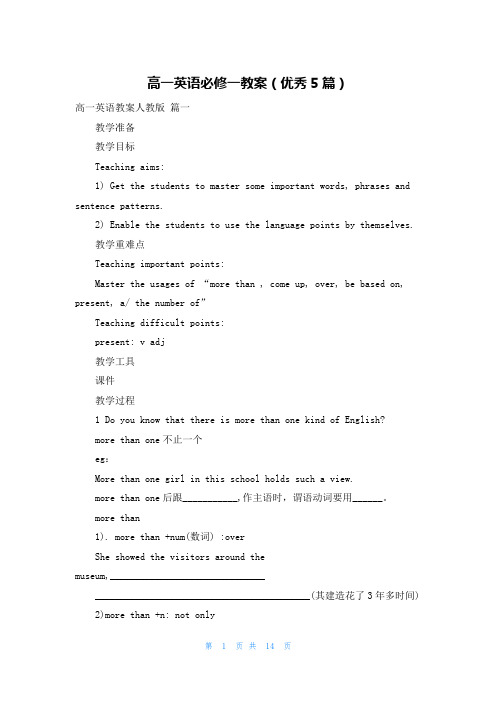
高一英语必修一教案(优秀5篇)高一英语教案人教版篇一教学准备教学目标Teaching aims:1) Get the students to master some important words, phrases and sentence patterns.2) Enable the students to use the language points by themselves.教学重难点Teaching important points:Master the usages of “more than , come up, over, be based on, present, a/ the number of”Teaching difficult points:present: v adj教学工具课件教学过程1 Do you know that there is more than one kind of English?more than one不止一个eg:More than one girl in this school holds such a view.more than one后跟___________,作主语时,谓语动词要用______。
more than1). more than +num(数词) :overShe showed the visitors around themuseum,__________________________________________________________________________(其建造花了3年多时间) 2)more than +n: not onlyMusic is more than just a sound--- it’s a way of thin king.3) more than +adj/v : very听到这个消息我很高兴。
高一英语人教Unit 5 Languages around the World教学设计
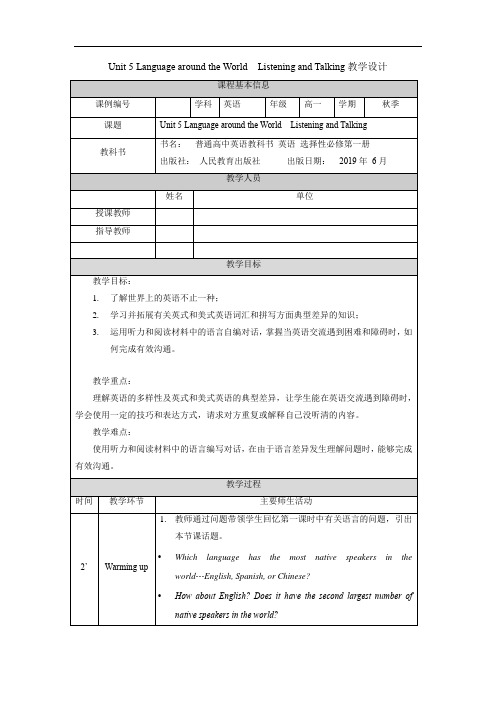
4. 教师和学生分角色朗读对话,加深熟悉度,为后面的自编对话储备语言支持。
6’
Speaking:
Activity 4
1.学生阅读对话并回答问题。
What does Zhou Wei want to buy?
Why does Martin feel puzzled about what Zhou Wei wants to buy?
Why do they misunderstand each other?
3.教师给出例子,引导学生关注除词汇以外,英式和美式英语在拼写方面的差异。
Look at the pairs of words.Which words are British English, and whihc are American English?
colour / color; centre / center; jewellery / jewelery
5.教师引导学生总结英式和美式英语的拼写常见规律,并以示例说明不是所有拼写差异都有规律。
What have you concluded from the previous activitites? Do you remember some of the rules for spelling?
Rules cannot cover everything. e.g. grey / gray; plough / plow
2.学生再次听录音,教师引导学生关注录音中讲到的不同种类英语在哪些方面有所差别,人们是否能在所使用的英语有所差别时,实现无碍沟通。
In what ways are these kinds of English different from each other? Are these differences great?Do people from these countries have problems in communication with each other?
新教材高一英语UNIT5教案
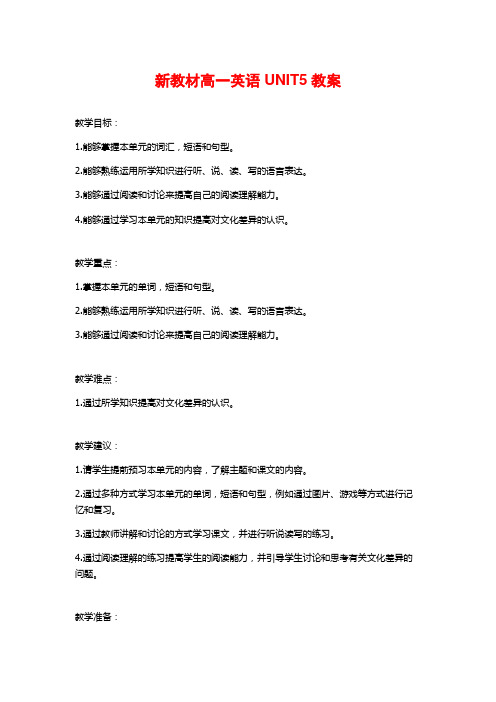
新教材高一英语UNIT5教案教学目标:1.能够掌握本单元的词汇,短语和句型。
2.能够熟练运用所学知识进行听、说、读、写的语言表达。
3.能够通过阅读和讨论来提高自己的阅读理解能力。
4.能够通过学习本单元的知识提高对文化差异的认识。
教学重点:1.掌握本单元的单词,短语和句型。
2.能够熟练运用所学知识进行听、说、读、写的语言表达。
3.能够通过阅读和讨论来提高自己的阅读理解能力。
教学难点:1.通过所学知识提高对文化差异的认识。
教学建议:1.请学生提前预习本单元的内容,了解主题和课文的内容。
2.通过多种方式学习本单元的单词,短语和句型,例如通过图片、游戏等方式进行记忆和复习。
3.通过教师讲解和讨论的方式学习课文,并进行听说读写的练习。
4.通过阅读理解的练习提高学生的阅读能力,并引导学生讨论和思考有关文化差异的问题。
教学准备:1.教师准备本单元的课文、习题和相关的教学资源。
2.学生准备课本和笔记等学习材料。
教学步骤:Step 1:导入(5分钟)根据学生的预习情况,教师可以通过提问等方式引导学生回顾上一单元的知识,并激发学生对本单元的兴趣。
Step 2:呈现(10分钟)教师可以通过PPT或者实物等方式呈现本单元的词汇和短语,并让学生进行跟读和记忆,同时教师可以给学生一些记忆方法和技巧。
Step 3:讲解(15分钟)教师可以通过教师讲解和示范的方式讲解本单元的重点句型和语法点,并举例说明,让学生理解其用法和意义。
Step 4:练习(20分钟)教师可以设计多种练习形式,例如填空、选择、对话等,来让学生进行语言的操练和巩固。
同时教师可以提供一些语言表达的模板和句型。
Step 5:拓展(15分钟)通过引导学生进行阅读理解的练习,让学生了解相关的文化背景和差异,并进行讨论和思考。
同时教师可以引导学生根据自己的经验和观察来分析和解释文化差异。
Step 6:总结(5分钟)教师可以通过对本节课的内容和重点进行总结,帮助学生巩固所学知识,并提出自学的建议和方法。
人教版英语高一必修一Unit5说课稿
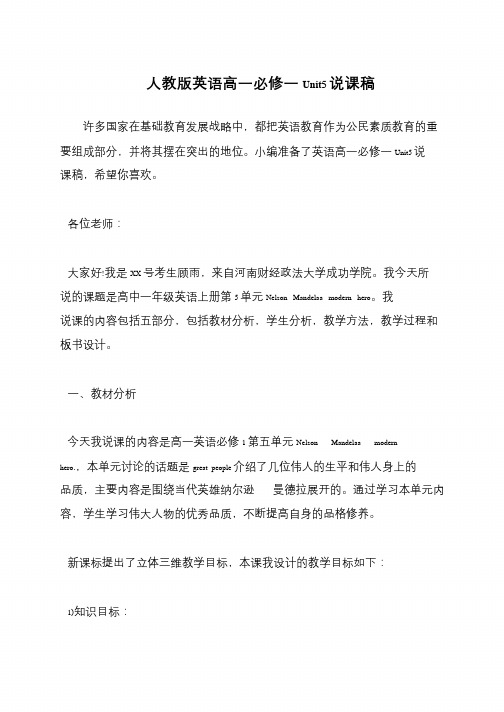
综合运用语言的能力。指出:教师在教学才过程中应与学生积极互动、共同
发展。教师应尊重学生的人格,关注个体差异,满足不同学生的学习需要,
创设能引导学生主动参与的教育环境,激发学生的学习积极性,培养学生掌
握和运用知识的态度和能力,使每个学生都能得到充分的发展。因此,本课
弱的学生能听懂,调动他们的积极性,使他们愿意学,在学习的过程中享受
到乐趣。虽然对英语有一定的兴趣但其学习主动性仍有待提高,未能积极主
动地通过其他渠
道获取信息,自主学习、探究学习的能力还有待于提高。本节课的话题较
贴近生活,可以引导学生在原有的知识经验基础上通过合作探究学习构建新
的知识经验和信息输入。
所以考虑到学生的特点,本次课程我主要采取任务型教学法,视听教学
法,问答法等教学方法。
四、教学过程
STEP1导入lead-in
在课堂开始,我会给学生展示一些同学们所熟知的名人的图片让学生能通
过图片来推测出这次课的话题是英雄hero当展示到曼德拉这位名人的图片
时,我会问doyouknowtheman?引出我们这堂课的标题。激起学生去了解
这篇文章的好奇心,迅速进入课堂。
1)教学重点
②提高学生的阅读能力,掌握多种阅读方法,如寻读,精读,理解等。
2)教学难点励学生开口说英语。
三.学情分析和教学方法的选择
高一年级的学生已经在初中阶段的英语学习中,已经积累了一定的词汇基础,
并掌握了一些简单的学习策略和技巧,具有初步的英语听说读写能力。但学生
的英语水平参差不齐,教学既要进一步培养尖子的学习能力又要保证能力稍
活中许多地方都用得到英语。小编准备了高一英语必修一说课稿,具体请看
高一英语 人教版 Unit 5 全单元教案
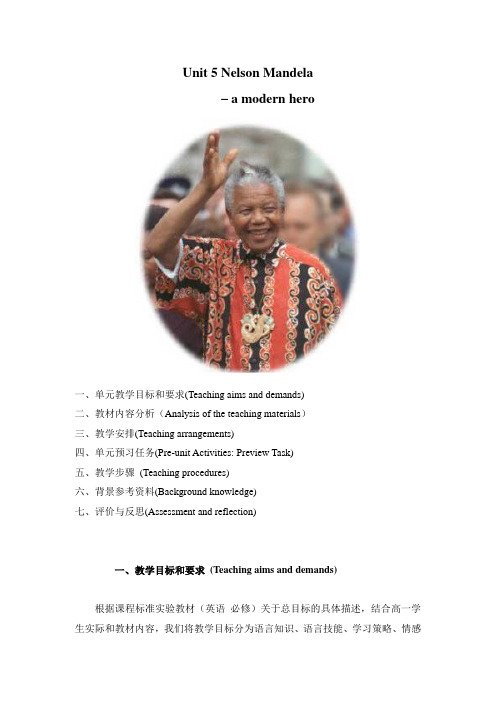
Unit 5 Nelson Mandela– a modern hero一、单元教学目标和要求(Teaching aims and demands)二、教材内容分析(Analysis of the teaching materials)三、教学安排(Teaching arrangements)四、单元预习任务(Pre-unit Activities: Preview Task)五、教学步骤(Teaching procedures)六、背景参考资料(Background knowledge)七、评价与反思(Assessment and reflection)一、教学目标和要求(Teaching aims and demands)根据课程标准实验教材(英语必修)关于总目标的具体描述,结合高一学生实际和教材内容,我们将教学目标分为语言知识、语言技能、学习策略、情感态度和价值观四个方面。
1.语言知识(Knowledge)词汇(Vocabulary):能理解、内化、运用以下生词----hero, quality, willing, active, republic, fight, peaceful, prison, prisoner, period, law, advise, continue, fee, g old,youth,league,stage,vote,position,accept,violence,equal,blanket,degree,guard,educated,terror,fear,cruelty,reward,right(n.),criminal,leader,president,sentence (v.),sincerely短语(Phrases and expressions):lose heart, in trouble ,worry about, out of work, Youth League, as a matter of fact, blow up, put ... in prison, come to power , set up , be sentenced to功能(Functions):学习掌握一些用于发表意见与评论的结构句式,如:1.发表意见(Giving opinions)Why do you think so? What do you think of ...? What's you opinion?agree / don't agree.I think / don't think .... I prefer .... In my opinion .... I'm afraid ....2.评论(Making comments)Good idea! That's an excellent idea.语法(Grammar):定语从句(II)(由where, when, why, 介词+ which, 介词+ whom 引导的定语从句)The person to whom you should be grateful for a peaceful South Africa is Nelson Mandela.扩展词汇:negative(消极的), heroine(女主角,女主人公), unwilling(不情愿的), nation(国家,民族), sacrifice(牺牲),realize(认识到), give up(放弃), riches(财富), Bible (圣经), revolution(革命), career(职业), equality(平等), fairness(公平), conflict(冲突), biography(自传), beliefs(信仰), Christianity(基督教), religion (宗教), priests(牧师), version(翻译), readable(易读的), adventure(冒险), scholar(学者), sympathy(同情), ,campaign(从事活动), communist(共产主义者), injustice(不公平), oppose(反对), pilot(飞行员), boycott(联合抵制)。
Unit5Languagesaroundtheworld单元整体教学设计-人教版高中英语
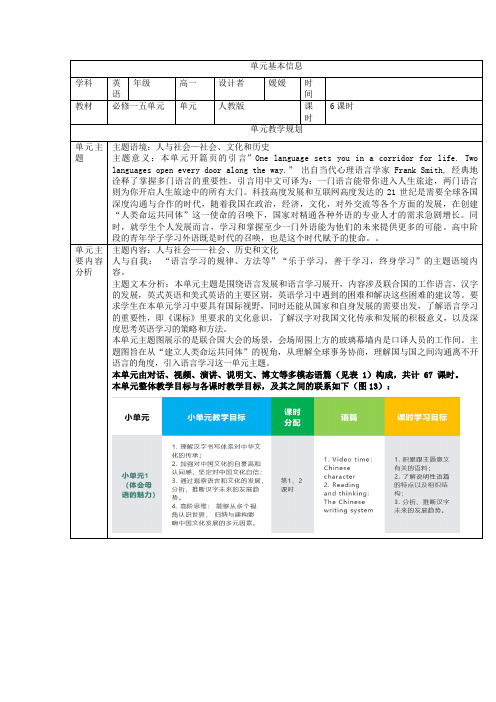
段的青年学子学习外语既是时代的召唤,也是这个时代赋予的使命。
主题内容:人与社会——社会、历史和文化
人与自我: “语言学习的规律、方法等”“乐于学习,善于学习,终身学习”的主题语境内容。
主题文本分析:本单元主题是围绕语言发展和语言学习展开,内容涉及联合国的工作语言,汉字的发展,英式英语和美式英语的主要区别,英语学习中遇到的困难和解决这些困难的建议等。
要求学生在本单元学习中要具有国际视野,同时还能从国家和自身发展的需要出发,了解语言学习的重要性,即《课标》里要求的文化意识,了解汉字对我国文化传承和发展的积极意义,以及深度思考英语学习的策略和方法。
本单元主题图展示的是联合国大会的场景,会场周围上方的玻璃幕墙内是口译人员的工作间。
主题图旨在从“建立人类命运共同体”的视角,从理解全球事务协商,理解国与国之间沟通离不开语言的角度,引入语言学习这一单元主题。
本单元由对话、视频、演讲、说明文、博文等多模态语篇(见表 1)构成,共计 67 课时。
本单元整体教学目标与各课时教学目标,及其之间的联系如下(图13):。
人教高一英语单元教学目标及教学要求
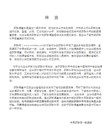
the reason why he is happy is that
35. much too / too much
36. all the time
37. a man named Chuck
38. it's time for ... / to do sth.
有区别
去郊游
不必
真表/真空
对......感兴趣
全世界
在......(时间)前
玩乐
她也不......
我也是这样的
我哥哥也是
打你的那个人
坏了的那张桌子
说.....,还说....
要关心的人
如果你错了,你将......
我正走差,突然我听到了......
冒险故事
分享快乐
3. quarrel/ disagree/argue (with / against sb.) about /on something
4. solve the problem
5. be into
6. too much/many
7. be fond of
8. all the same
23. regard...as...
24. be afraid of (doing) sth
25. be quick in
26. not ... any longer
27. be angry with sb /at sth
28. tell a lie
29. there is sth wrong with...
本文档是本人花费多年,收集整理的,精心挑选!
人教版高一英语必修一第四单元教学目标

人教版高一英语必修一第四单元教学目标
人教版高一英语必修一第四单元的单元标题是“Wildlife Protection”,主题是“野生动物保护”。
以下是本单元的教学目标:
1. 知识目标:学生能够掌握和理解本单元所学的词汇、短语和句型,包括各种野生动物名称、保护措施、生态平衡等方面的表达。
2. 能力目标:学生能够运用所学知识,就野生动物保护的话题进行简单的口头和书面表达,能够进行简单的阅读和写作练习,提高语言运用能力。
3. 情感态度和价值观目标:通过本单元的学习,增强学生保护野生动物的意识,培养热爱大自然、尊重生命的观念,提高环保意识。
本单元的教学重点和难点如下:
重点:掌握野生动物名称、保护措施、生态平衡等方面的词汇和表达方式。
难点:理解和运用所学知识进行口头和书面表达,提高语言运用能力。
为了实现这些教学目标,建议教师在教学过程中采取以下措施:
1. 创设情境:利用图片、视频等多媒体手段,展示野生动物的生活环境和面临的威胁,引导学生进入情境,增强情感体验。
2. 小组合作:组织学生进行小组讨论,分享彼此对野生动物保护的认识和想法,提高合作意识和沟通能力。
3. 案例分析:选取一些野生动物保护的案例,让学生分析其中的问题和解决方案,培养批判性思维和解决问题的能力。
4. 拓展阅读:推荐一些关于野生动物保护的英文文章或网站,引导学生进行拓展阅读,提高阅读能力和文化素养。
5. 作业与评价:布置与本单元主题相关的作业,如写一篇关于野生动物保护的短文或制作一份宣传海报等,通过多种方式进行评价和反馈,帮助学生发现不足并改进。
人教版高中英语必修1教学计划5篇
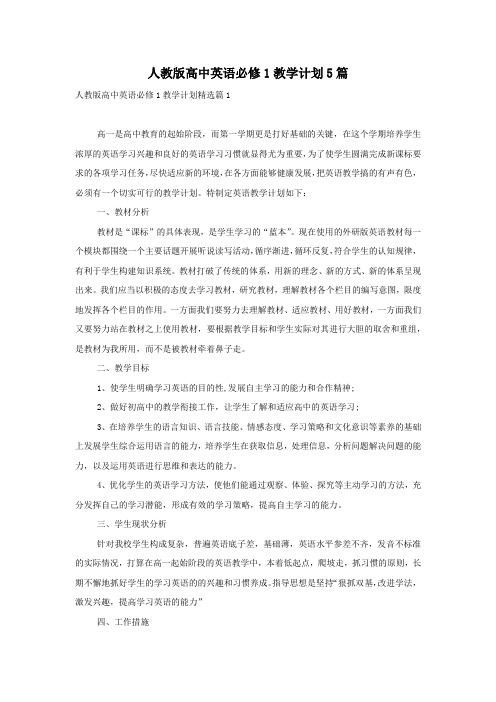
人教版高中英语必修1教学计划5篇人教版高中英语必修1教学计划精选篇1高一是高中教育的起始阶段,而第一学期更是打好基础的关键,在这个学期培养学生浓厚的英语学习兴趣和良好的英语学习习惯就显得尤为重要,为了使学生圆满完成新课标要求的各项学习任务,尽快适应新的环境,在各方面能够健康发展,把英语教学搞的有声有色,必须有一个切实可行的教学计划。
特制定英语教学计划如下:一、教材分析教材是“课标”的具体表现,是学生学习的“蓝本”。
现在使用的外研版英语教材每一个模块都围绕一个主要话题开展听说读写活动,循序渐进,循环反复,符合学生的认知规律,有利于学生构建知识系统。
教材打破了传统的体系,用新的理念、新的方式、新的体系呈现出来。
我们应当以积极的态度去学习教材,研究教材,理解教材各个栏目的编写意图,限度地发挥各个栏目的作用。
一方面我们要努力去理解教材、适应教材、用好教材,一方面我们又要努力站在教材之上使用教材,要根据教学目标和学生实际对其进行大胆的取舍和重组,是教材为我所用,而不是被教材牵着鼻子走。
二、教学目标1、使学生明确学习英语的目的性,发展自主学习的能力和合作精神;2、做好初高中的教学衔接工作,让学生了解和适应高中的英语学习;3、在培养学生的语言知识、语言技能、情感态度、学习策略和文化意识等素养的基础上发展学生综合运用语言的能力,培养学生在获取信息,处理信息,分析问题解决问题的能力,以及运用英语进行思维和表达的能力。
4、优化学生的英语学习方法,使他们能通过观察、体验、探究等主动学习的方法,充分发挥自己的学习潜能,形成有效的学习策略,提高自主学习的能力。
三、学生现状分析针对我校学生构成复杂,普遍英语底子差,基础薄,英语水平参差不齐,发音不标准的实际情况,打算在高一起始阶段的英语教学中,本着低起点,爬坡走,抓习惯的原则,长期不懈地抓好学生的学习英语的的兴趣和习惯养成。
指导思想是坚持“狠抓双基,改进学法,激发兴趣,提高学习英语的能力”四、工作措施1、继军训后结合学生初中英语实际状况,用一个星期左右复习五种简单句型和语音知识,为平稳向高中教材过度奠定基础,梳理初中知识,配发相应练习,通过习题讲练,激发学生对新知识的求知欲,顺利进入新教材的学习。
高一英语必修一unit5教案

高一英语必修一unit5教案教案名称:Unit 5: Meeting Your New Classmates教学目标:1. 通过学习本单元,学生将能够运用描述人物特征和外貌的词汇,并能够进行简单的自我介绍。
2. 学生将能够在日常生活中运用所学的词汇和句型进行交流,并能够发展有效的交际能力。
3. 学生将培养对他人的关心和尊重,增强团队合作意识。
教学重点:1. 掌握描述人物特征和外貌的词汇。
2. 学会运用目标语言进行简单的自我介绍。
3. 发展有效的交际能力。
教学难点:1. 学生能够使用目标语言进行简单的自我介绍。
2. 学生能够在日常生活中运用所学的词汇和句型进行交流。
教学准备:教材:高中英语必修一(人教版)第五单元的教科书、课后习题、配套教学光盘等。
辅助教具:录音机、多媒体设备、图片、班级展示板等。
教学过程:Step 1: Warm-up (5 minutes)1. Greetings: Greet the students and ask them how they are doing.2. Show pictures of people with different appearances (such as tall, short, fat, thin, etc.) and ask students to describe their appearances.3. Ask students to introduce themselves to their classmates briefly.Step 2: Presentation and Practice (25 minutes)1. Introduce new vocabulary related to physical appearance and personality traits, such as tall, short, fat, thin, funny, serious, etc. Use pictures and gestures to help students understand and remember the words.2. Play the audio files to help students practice pronouncing the new words.3. Ask students to work in pairs and describe their partners using the new vocabulary. For example, \。
Unit5Music大单元整体教学设计-高中英语人教版
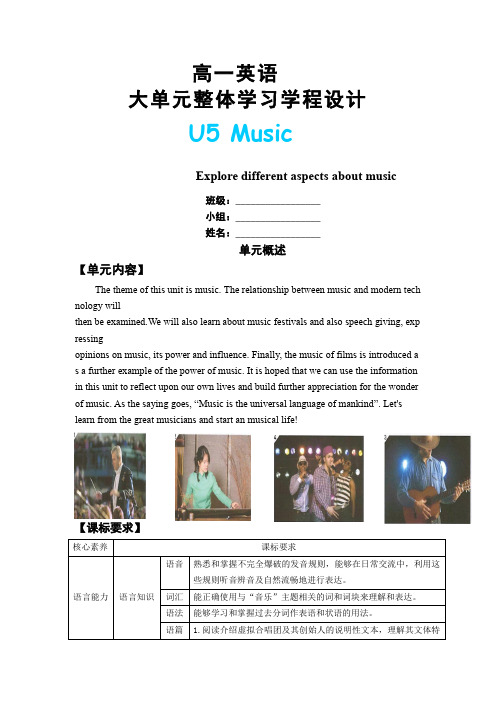
高一英语大单元整体学习学程设计U5 MusicExplore different aspects about music班级:_________________小组:_________________姓名:_________________单元概述【单元内容】The theme of this unit is music.The relationship between music and modern tech nology willthen be examined.We will also learn about music festivals and also speech giving,exp ressingopinions on music,its power and influence.Finally,the music of films is introduced a s a further example of the power of music.It is hoped that we can use the information in this unit to reflect upon our own lives and build further appreciation for the wonder of music. As the saying goes, “Music is the universal language of mankind”. Let's learn from the great musicians and start an musical life!【课标要求】核心素养课标要求语言能力语言知识语音熟悉和掌握不完全爆破的发音规则,能够在日常交流中,利用这些规则听音辨音及自然流畅地进行表达。
词汇能正确使用与“音乐”主题相关的词和词块来理解和表达。
高一新高考英语教学目标(精选)

高一新高考英语教学目标(精选)高一新高考英语教学目标高一新高考英语教学目标主要包括以下几个方面:1.语言能力:学生能够通过语音、语法和用英语进行思维的能力,以及听说读写四方面的语言技能,达到高中英语教学的目标,并能运用英语来解释并表达思想。
2.语言学习:学生要继续扩大词汇量,掌握英语语法,了解英语的语言规律,同时培养学生对文化差异的敏感性和鉴别能力。
3.语言应用:学生要掌握英语的学习方法和学习策略,并能够将其应用于英语学习中。
4.跨文化意识:学生要了解英语国家的文化背景,培养学生对中西方文化差异的敏感性。
5.学习能力:学生要掌握科学的学习方法,并能自主学习,提高学习效率。
6.合作能力:学生要能够与他人合作,共同完成学习任务。
7.情感态度:学生要能够培养积极的情感态度,包括好奇心、求知欲、学习动机和自信心。
8.创新意识:学生要能够运用所学知识,尝试新的表达方式,扩展思维。
高一英语教学目标高一英语的教学目标应该是培养学生良好的听、说、读、写英语能力,并能够初步使用英语进行交际的能力。
具体来说,高一英语教学应该注重以下几个方面:1.语言基础:包括语音、语法、词汇、标点符号等基础知识,高一英语教学应该帮助学生掌握这些基础知识,并能够正确运用。
2.阅读理解:高一英语教学应该注重培养学生的阅读理解能力,帮助他们掌握阅读技巧,提高阅读速度和阅读理解能力。
3.写作能力:高一英语教学应该注重培养学生的写作能力,帮助他们掌握写作技巧,提高写作水平。
4.语言交际能力:高一英语教学应该注重培养学生的语言交际能力,帮助他们掌握基本的英语交际用语和表达方式,提高他们的英语口语和听力水平。
5.文化素养:高一英语教学应该注重培养学生的文化素养,帮助他们了解中西文化的差异,增强跨文化交流的能力。
总之,高一英语教学应该注重学生的全面发展,帮助他们掌握英语基础知识,提高语言技能和文化素养,为他们进一步学习英语打下坚实的基础。
高一英语教师教学目标高一英语教师的教学目标应该包括以下几个方面:1.帮助学生掌握基本的语言知识,包括词汇、语法、句型等。
人教版高一英语教学
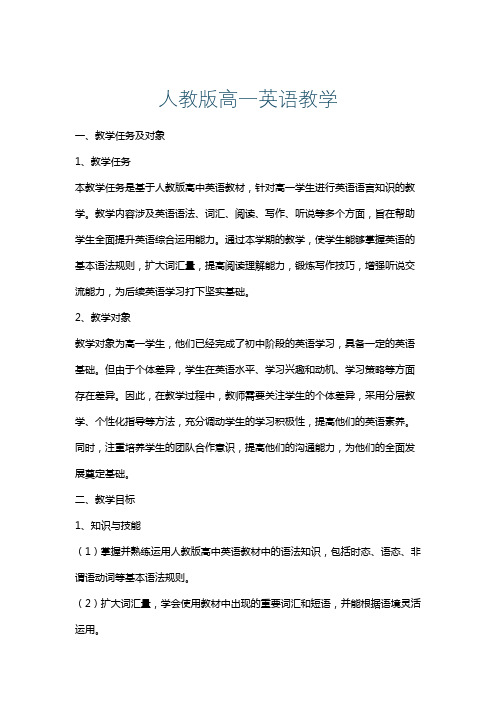
人教版高一英语教学一、教学任务及对象1、教学任务本教学任务是基于人教版高中英语教材,针对高一学生进行英语语言知识的教学。
教学内容涉及英语语法、词汇、阅读、写作、听说等多个方面,旨在帮助学生全面提升英语综合运用能力。
通过本学期的教学,使学生能够掌握英语的基本语法规则,扩大词汇量,提高阅读理解能力,锻炼写作技巧,增强听说交流能力,为后续英语学习打下坚实基础。
2、教学对象教学对象为高一学生,他们已经完成了初中阶段的英语学习,具备一定的英语基础。
但由于个体差异,学生在英语水平、学习兴趣和动机、学习策略等方面存在差异。
因此,在教学过程中,教师需要关注学生的个体差异,采用分层教学、个性化指导等方法,充分调动学生的学习积极性,提高他们的英语素养。
同时,注重培养学生的团队合作意识,提高他们的沟通能力,为他们的全面发展奠定基础。
二、教学目标1、知识与技能(1)掌握并熟练运用人教版高中英语教材中的语法知识,包括时态、语态、非谓语动词等基本语法规则。
(2)扩大词汇量,学会使用教材中出现的重要词汇和短语,并能根据语境灵活运用。
(3)提高阅读理解能力,能快速捕捉文章主旨,分析文章结构,理解作者观点。
(4)锻炼写作技巧,学会运用不同的句型和连接词,使文章结构清晰、内容连贯。
(5)增强听说交流能力,能熟练运用日常英语进行交流,掌握基本的听力技巧。
2、过程与方法(1)采用任务型教学法,让学生在完成具体任务的过程中,运用所学知识,提高实际运用能力。
(2)运用情景教学法,创设真实的语言环境,激发学生的学习兴趣,提高他们的参与度。
(3)利用多媒体教学资源,丰富教学手段,提高课堂教学效果。
(4)注重小组合作学习,培养学生的团队协作能力和沟通能力。
(5)开展课外活动,如英语角、英语演讲比赛等,为学生提供更多实践机会。
3、情感,态度与价值观(1)培养学生对英语学习的兴趣和自信心,使他们能够积极参与课堂活动,主动探索知识。
(2)引导学生树立正确的学习态度,养成良好的学习习惯,形成持续学习的动力。
高一英语单元整体教学设计
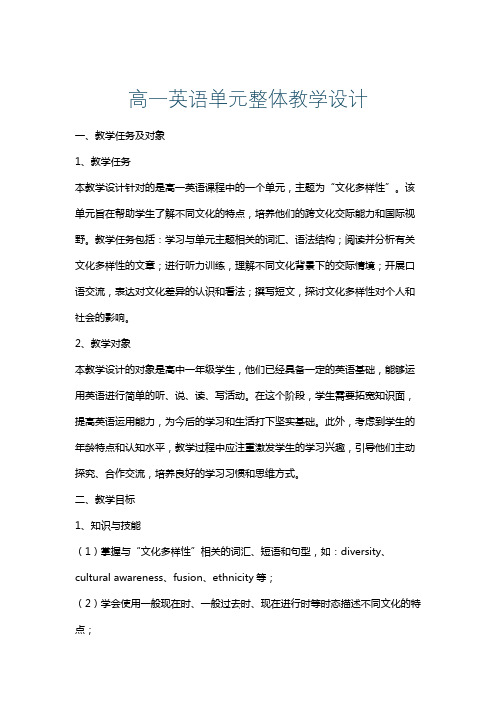
高一英语单元整体教学设计一、教学任务及对象1、教学任务本教学设计针对的是高一英语课程中的一个单元,主题为“文化多样性”。
该单元旨在帮助学生了解不同文化的特点,培养他们的跨文化交际能力和国际视野。
教学任务包括:学习与单元主题相关的词汇、语法结构;阅读并分析有关文化多样性的文章;进行听力训练,理解不同文化背景下的交际情境;开展口语交流,表达对文化差异的认识和看法;撰写短文,探讨文化多样性对个人和社会的影响。
2、教学对象本教学设计的对象是高中一年级学生,他们已经具备一定的英语基础,能够运用英语进行简单的听、说、读、写活动。
在这个阶段,学生需要拓宽知识面,提高英语运用能力,为今后的学习和生活打下坚实基础。
此外,考虑到学生的年龄特点和认知水平,教学过程中应注重激发学生的学习兴趣,引导他们主动探究、合作交流,培养良好的学习习惯和思维方式。
二、教学目标1、知识与技能(1)掌握与“文化多样性”相关的词汇、短语和句型,如:diversity、cultural awareness、fusion、ethnicity等;(2)学会使用一般现在时、一般过去时、现在进行时等时态描述不同文化的特点;(3)运用阅读策略(如:预测、扫读、精读等)分析文化多样性相关的文章,理解文章主旨和细节;(4)提高听力水平,能够理解不同文化背景下的交际情境,抓住关键信息;(5)通过口语交流,学会用英语表达自己对文化差异的认识和看法;(6)学会撰写关于文化多样性的短文,论述其对个人和社会的影响。
2、过程与方法(1)采用自主学习、合作学习和探究学习的方式,引导学生主动参与课堂活动;(2)利用多媒体教学资源,创设丰富的教学情境,激发学生的学习兴趣;(3)通过小组讨论、角色扮演等活动,培养学生的跨文化交际能力和团队协作精神;(4)结合生活实际,让学生在实践中感受文化差异,提高英语运用能力;(5)运用形成性评价和终结性评价相结合的方式,关注学生的学习过程和成果。
高一unit5全单元的教案(人教版高一英语上册教案教学设计)

高一unit5全单元的教案(人教版高一英语上册教案教学设计)Period 1 Warming-up and speakingTeaching Aims:Goal: 1.In this lesson, students will enhance their speaking abilities through talking about films.2. In this lesson, students will practice their skills of interviewing.Objectives:1. In this lesson, students will be able to describe the movie pictures.2. In this lesson, students will be able to act out an interview.Teaching Important Points:How to impro ve the students’ speaking ability.Teaching Aids:1.a computerTeaching Procedures:Step 1: Warming-upActivity1: GreetingsT: Class begins. Good morning, class!Ss: Good morning, Miss Yang!Activity 2: Talk about the types of filmT: Ok, class, do you like seeing films?Ss: Yes.T: Great minds think alike (英雄所见略同). I also like seeing films. What kind of film do you like? Let’s enjoy some film posters first.(Show the posters on the screen)T: Do you like these posters? Maybe except the last one. It isa bit terrible, right? Ok, the first poster tells a story of a lovely pig, and his name is “麦兜”. So, this kind of film is called cartoon film. Can you give any other examples? Such as “Finding Nemo” and Shrek. The second one is “E.T.”, so it’s science ficti on film”. I think you’re very familiar with the third one, it’s “我的野蛮女友”, so it is a love story. The fourth one is “古墓丽影”, so it is adventure film. The fifth one is the latest Jackie Chan’s film, it’s “New Police Story”. We call it action film. Ok, now let’s come to the last one. It looks very terrible, right? So, it’s horrible film.T: Which kind do you like best? Maybe most of girls like love stories, such as “Titanic”, while boys like action films, such as “New Police Story”.T: Ok, ××, which film impres sed you most? Why? Who is your favorite actor/actress? What do you think of him/her?(Ask 2-3 students to answer)Activity 3:Talk about the film postersT: Ok, class. Just now we’ve talked something about “The silver screen”, it means “银屏” in Chinese. You know I’m also a movie fan. I like collecting film posters. I want to share them with you. Do you want to have a look?(Show the film poster “Stuart Little”, and stick it on the blackboard)T: Who is he? In Chinese we call him “精灵鼠小弟”. Yes, he is Stuart Little. Do you like him? I think he is so lovely! What is he different from other mice? He can speak, think and do everything a person can do. He has fingers, legs and he wears clothes and a hat. What clothes does he wear?Ss: He wears a yellow T-shirt, a red sweater and blue trousers.T: Yes, and he wears a pair of sport shoes. Maybe they aremade in Wenzhou. He is so cool, right? What’s under his feet?Ss: It’s a beautiful skateboard.T: Ok, can you guess what is he going to do?Ss: ……T: Maybe he is going to rescue his friend, the little bird Margalo, from the mouth of Falco. Then what kind of film do you think this is?Ss: It’s a cartoon film.T: Very good. Now, I want to show you some other posters. Please open your books and turn to page 29. There are four film posters on the book. Please discuss them with your partner, asking as many questions as you can. You also can ask these questions on the screen.Q1: What can you see in the poster?Q2: What does he/she wear?Q3: What’s the color of his/her clothes?Q4: What is happening in this scene?Q5: What do you think happens before this scene?Q6: What do you think happens after this scene?Q7: What kind of film do you think this is?(Explain the first one to the students, then give students 3 minutes to prepare and ask 3 pairs to act them out)Step 2: SpeakingActivity 1: Enjoy the video of “The Matrix”T: Boys and girls, because all of you have done a good job, so I want to give you a reward. Now I will show you something interesting, please enjoy it.(S how the video of “The Matrix”, about 2 minutes)Activity 2: Introduce the two famous film stars to the studentsT: What’s the name of this film?Ss:……T: Yes, it’s “The Matrix”. Do you like “Neo”? (Show his photos on the screen) I think he is pretty handsome. Do you know the actor’s name? He is “Keanu Reeves”. Before this class, I’ve heard a wonderful news: Keanu Reeves will come to China today with another famous American actress Meryl Streep. They will take part in CCTV’s interview program---Life of Art. To your surprise, Zhujun will choose our classroom to interview them and he will give the chance to you. You’re so lucky, right? I think we must make full preparation of it. Ok, please turn to page 30, read the two biographies first, and find out the difficult points. I will explain to you later.(Give students 2 minutes to read, and then explain some language points)Language points:1.While still a student, ……= while she was still a student, ……2.Play roles in : act roles in …3.Meryl Streep made her first film, called Julia in 1977.Called = which was called JuliaActivity 3: Interview the two famous film starsT: Ok, now please read the two biographies again, and think out as many questions as you can. What you want to ask these two superstars? You can discuss with your partner and write the questions on the paper. If you like, you also can use the questions on the screen.Questions:Can you tell us something about the place where you grew up?Can you tell us something about the time where you wereyoung? What were your dreams? What made you decide to become an actor/actress?What did you do next? Were there any special reasons why you started working in film?What roles did you act?How long have you been working as an actor/actress?What do you like to do in your spare time?What will you do if you are not an actor/actress?When will you get married?(Give students enough time to prepare)T: Are you ready? Now I will act as Meryl Streep. You can ask any questions if you like. Hands up please!(Give students 3 minutes to ask questions)T: You have done a very good job. Let’s stop here. Now I’d like to choose a boy to act as Keanu Reeves. Who’d like to try?(Choose a boy to act as Keanu Reeves, and ask him to come to the blackboard)Step 3: SummaryT: Ok, Let’s stop here. In this class, we’ve talked about some famous films, actors and actresses. I’m very glad to see that all of you have done a good job. Ok, today’s homework:1. Talk about your favorite film with your partner in English by using the sentences we have learned today.2.Preview the reading part “Getting to know Steven Spielberg”.Period 2 ReadingGetting to know Steven SpielbergTeaching Aims:1. Train the students’ reading ability.2. Learn the following words and phrases: scene, script,ac ademy, studio, take off, blockbuster, cut…into pieces, dinosaur, go wrong, follow-up, cruelty, in the endTeaching Important Points:1. How to make the students understand the reading text better.2. Learn and master the following phrases: work on, take off, cut…into pieces, hit, go wrong, in the end, owe…to…Teaching Different Points:1. The differences between the following pairs of words or phrases: be afraid of doing sth. /be afraid to do sth. , high/highly2. Learn the following sentence pattern: …love and friendship are the most important things in life.Teaching Methods:1. Fast reading to get a general idea of the text.2. Question-and-answer activity to get the detailed information in the text.3. Explanation for students to master some language points.Teaching Aids:1. A computerTeaching Procedures:Step 1: GreetingsGreet the whole class as usual.Step 2: Pre-readingT: In the last period, we learned something about the silver screen (write on the Bb). Now, let’s play a game. Please tell me something about the silver screen. I’ll divide you into 2 groups. These two are group A; these two are group B. Let’s have a competition. See, which group will win? Are you clear? Now I will give you an example first. For example: director. Let’s begin.Bb: G.B. G.A.director(make) film/movie actorscene actressscript Silver screen studio(win) award (play, take, act) roleOscar/Academy Award Hollywoodproducer music(Play the game and decide which group is the winner)T: Ok, just now we listed many things that are related to the Silver screen. Can you tell me which is the most important one?Ss: …T: In my opinion, I think director is the most important one. We can say director is the soul of a film. Do you know any Chinese director? Who are they?Ss: Zhang Yimou, Chen Kaige, Tian Zhangzhang, and Feng Xiaogang…T: Very good. Now I want to introduce an American director to you. Listen to me carefully and guess who he is? He is one of the top directors in the world. He is also a producer. He won 2 Oscar Awards for Best Director. Some of his films are very familiar to us, such as: Jurassic Park, E.T., Saving Private Ryan. And he found the Dream Work SKG. Who is he?Ss: He is “Steven Spielberg”.T: Very good. Do you like him? Now let’s learn something more about him. Please open your books and turn to page 31: “Getting to know Steven Spielberg”.Step 3: ReadingActivity 1: Fast-readingT: Please mark the paragraphs first. Now, please read the whole text as quickly as you can and answer the questions on thescreen.Questions:1. What was Spielberg’s dream?2. How many films are mentioned in the passage? What are they?(Teacher gives students 5 minutes to read the passage and then asks some students to answer the questions.)Suggested answers:1. His dream was to go the Film Academy.2. Five. They are “Jaws”, “E.T.”, “Jurassic Park”, “Schindler’s List” and “Saving Private Ryan”.Activity 2: Careful-readingT: Now we have a general idea of Steven Spielberg. Next, let’s learn more details about him. Please read the f irst 2 paragraphs slowly and carefully and fill in the table on the screen.Name Sex19461958(twelve)1959(thirteen)1962(sixteen)GradesJobs(Ask a group of students to answer)T: You’ve done a very good job. Now please think over this question: “Why did Spielberg study English instead of film?”(Ask one student to answer)Suggested answer:3. Because his grades were too low.T: In these two paragraphs, we should pay attention to the phrase “take off”, it has many meanings, such as “脱掉,(飞机)起飞”, here it means “success”, “成功”.e.g.: I hear the business is really taking off.T: Now please read the following 4 paragraphs carefully and finish the table on page 32, the second exercise. What are these films about? You can discuss with your partner.Jaws (1975)E.T. (1982)Jurassic Park (1993)Schindler’s List (1993)Saving Private Ryan (1998)(Teacher gives students 2 minutes to prepare, and then ask someone to answer)T: You have done a good job. Next, let’s think about this question: “Why were people who saw th e film Jaws afraid to swim in the sea?”(Answer this question together)Suggested answer:4. Because they remembered the scenes in which people were eaten by the shark.(Teacher explains the language points of these 4 paragraphs to the students: be afraid to do sth/of doing sth, be afraid of doing sth/be afraid +that clause, cut…into pieces, do research, go wrong)T: Ok, class, by now we’ve already known something about Spielberg’s life and his films. There is a Chinese saying: “There is always a woman behi nd a successful man.” Right? Let’s see who is the woman behind Spielberg? Please read the last paragraph carefully and answer the question: “How important is Spielberg’s family to his career?”(Teacher gives students 1 minute to prepare)T: Ok, what’s the name of Spielberg’s wife?Ss: She is Cate Capshaw.T: Then how important is his family to Spielberg’s career?(Ask one student to answer this question)Suggested answer:5.He owes much of his success and happiness to his wife and children. That’s the secre t of his success.T: Here “owe…to…” means “把…归功于某人”.Step 4: Post-readingT: Ok, by now we’ve learned the whole passage. We know Spielberg’s family, childhood, grades, jobs, dream and most important: his films. Now please think over the question: What have you learned from reading about Spielberg? Or what should you do if you want to be success? You can discuss it with your partner.(Teacher gives students enough time to prepare and ask some students to give their opinions.)Suggested answers:What we learn about Steven Spielberg is that his passion for film, hard work and perseverance have made him who he is.Remember: Working hard and believing in your dream will make your dream come true.Step 5: SummaryT: That’s all for today. At last, let’s enjoy a fil m, which was directed by Steven Spielberg.(Enjoy the video of “Minority Report”, about 2 minutes.)Step 6: Homework1.Finish the Word study on page 32.2.Finish Vocabulary 1 on page 110.3.Find out the Attributive Clauses in the text.Period 3 GrammarTeaching Aims:1. Review the text learned in the last period.2. Learn the Attributive Clause with prepositions.3. Learn the Attributive Clause introduced by relative adverbs “where, when and why”.Teaching Important Points:1. The usages of “prep. + the relative pronoun”.2. The usages and functions of the relative adverbs.Teaching Difficult Points:1. The choice of the prepositions in the Attributive Clause.2. The choice of the relative adverbs.Teaching Methods:1. Consolidate the words learnt using the review method.2. Learn some usages of Attributive Clause using explanation and inductive methods.3. Individual or pair works to make every student work in class.Teaching Aids:1. A computerTeaching Procedures:Step 1: GreetingsGreet the whole class as usual.Step 2: RetellT: In the last period, we’ve learned something about Steven Spielberg. Do you still remember him? Now, I’d like someone retell the text. You can use the information on the screen if you like.(Teacher asks a student to retell the text)Step 3: RevisionT: In the last unit, we have learned the usages of the relative pronouns. Can you tell me how many relative pronouns are there? What are they?Ss: Five. They are “who, whom, whose, that and which”.T: Right. Now let’s do an exercise to review them. Look at the screen please.Choose the proper relative pronouns to fill in the blanks.1. October 1, 1949 is the day______ we’ll never forget.A. whenB. whoseC. thatD. it2. Is this the shop_______ sells children’s clothing?A. whichB. whereC. in whichD. what3. His parents wouldn’t let him marry anyone______ family was poor.A. of whomB. whomC. of whoseD. whose4. Do you know the boy_______ is standing at the gate of our school?A. whoB. whichC. whomD. whose5. All_______ glitters is not gold.A. thatB. whichC. /D. what6. The woman_______ you saw just now is my aunt.A. whoB. whomC. whichD. whose(Teacher asks the students to give the answers. If they make mistakes, teacher points them out and corrects them.) Suggested answers:1.C2.A3.D4.A5.A6.BStep 4: Grammar StudyActivity 1: Learn “preposition + whom/which”T: The relative pronouns are used as objects either after verbs or after prepositions. When they are used as the objects of prepositions, the position of the prepositions must be paidattention to. The preposition usually follows the verb in spoken English. “Who” “whom” “that” or “which” can be used and they are usually omitted in spoke English. If the preposition is used before the relative pronoun, “which” or “whom” can only be used and they cannot be omitted. That is “preposition + whom/which”. Please look at the examples on the screen.e.g. 1. A. The woman who/whom Spielberg is married to is an actress.B. The woman to whom Spielberg is married is an actress.2.A. The person (who/that/whom) you should write to is Mr. Ball.]B. The person to whom you should write is Mr. Ball.T: Then, how can we choose the proper preposition? First, we can find out which verb the preposition is used with in the clause. Second, we can find out which noun or pronoun the clause modifies. Third, we can find out the meaning of the clause. Ok, I’ll show you some examples to make you clear. Please open your books and turn to page 33. Look at the examples of exercise3.e.g.: The painting at which I looked was painted by Vincent van Gogh.The girl with whom you talked at the meeting is a college student.(Explain the two examples to the students.)T: Are you clear? Now please finish exercise 3 within 2 minutes.(Ask a group of students to answer)Activity 2: Check the Attributive Clauses in the reading passage.T: Next, let’s check the Attributive Clauses in the text. See,who will do the best job? Have you finished?(Finds out the Attributive Clauses with the students and points out their mistakes.)Activity 3: Learn the relative adverbsT: We’ve mastered the usages of relative pronouns. Next, we’ll learn the usages of the relative adverbs: “where, when and why”. “When” is used for time, “where” for place and “why” for reason.e.g.: Jurassic Park is about a park where a very rich man keeps different kinds of dinosaurs.1958 was the year when Spielberg made his first real film.The reason why Spielberg could not go to the Film Academy was that his grades were too low.(Explain these sentences to the students)T: Are you clear? Ok, now let’s do the first exercise on page 33.(Check the answers with the students)T: But we also should pay attention to some special cases. Look at the examples on the screen.e.g. 1. Hangzhou is the place _______ I visited last summer.2.Hangzhou is the place _______I went last summer.3.The reason_______ she gave for not coming to the party is that her mother wouldn’t let her.A. whatB. whyC. thatD. as(Explain these sentences to the students)Suggested answers:1. which/that 2 where 3. CActivity 4: Learn “relative adverbs = preposition+ which”T: The relative adverbs “when” “where” and “why” can be replaced by “preposition + which”.When = in /on/at/during whichWhere = in /at/on/ whichWhy = for whichT: Then, how can we choose the right preposition? It depends on the noun or pronoun that the Attributive Clause modifies. Are you clear? Let’s look at some examples on the screen.e.g. The reason ____________ Peter is so happy is that he passed the exam.I remember the day ___________ my father died. I was only ten years old at that time.I will go back to the place _____________ I grew up and live there forever.Suggested answers:1. why/for which2. when/on which3.where/in(at)whichT: Now let’s finish the second exercise on page33. Please do it carefully.(Check the answers one by one)Step 5: HomeworkT: That’s all for today. Your homework:1.Finish the Grammar parts of your workbook.2.Preview the Integrating Skills “Not One Less”.Period 4 Listening and Integrating SkillsTeaching Aims:1.Train the students’ listening ability.2.Train the students’ writing ability.Teaching Important Points:1.How to improve students’ listening ability.2.How to make comments and give opinions.3.How to train the student s’ writing ability.Teaching Difficult Points:How to improve the students’ integrating skills.Teaching Methods:1.Listening and answer activity to help the students go through with the listening text.2.Asking –and-answer activity to go through the reading material.3.Individual or group work to train the students’ writing ability.Teaching Aids:1.a computerTeaching Procedures:Step 1: GreetingsGreet the whole class as usual.Step 2: ListeningActivity 1: Pre-listeningT: In this unit, we’ve learned many things about the Silver screen, the films, the actors/actresses and the director-Steven Spielberg. What we have learned from him is that working hard and believing in your dream will make your dream come true. Today, I want to introduce Mr. Malcolm Langland, a famous actor to you. He is also such kind of person. Let’s listen to an interview of Mr. Langland. See, what had happened on him? And how he insisted on his dream?Activity 2: While-listeningT: When you listen for the first time, please finish the exercises on the screen. Remember to take notes when you listen to the tape.Choose the right answers:1. What was Mr. Malcolm’s dream when he was young? ( )A. He dreamt of being a teacher.B. He dreamt of being a lawyer.C. He dreamt of being a film star.2. Why didn’t ngland study art? ( )A. He had no chance.B. His father did not want him to study art.C. He liked law better than art.3. When did Mr. Langland decide to become an actor? ( )A. Before he joined the Student Club.B. When he met his wife at the Student Club.C. After he graduated from the school.(Check the answers with the students)T: Now let’s listen again. This time please finish filling in the blanks on the screen. Before you do it, please read these questions carefully.(Teacher gives students 1 minute to read)T: Now, let’s begin. I’ll pause after important sentences.Listen to the interview with Mr. Malcolm Langland and answer the following questions:1.What do we know about the city where Malcolm grew up?It was _______________ far from the _________.2. What did he want to be when he was a student?When Malcolm was young he wanted to be ___________.3. What was the reason why Malcolm studied law?The reason is ____________ wanted him to ___________.4. When did Malcolm really start his career in the theatre?When he met __________, he started his career in the theatre.5. Why was the film called The Dream Machine important to Malcolm?It was important because he did not have any _____________.(Check the answers with the students, and let them listen again if necessary.)Step 3: Integrating SkillsT: Are you tired or not? Anyway, let’s relax for a while. Let’s enjoy some beautiful film posters.(Show 4 film posters on the screen)T: What’s the name of them?Ss: They are “My father and Mother”, “Lover”, “Raise the Red Lanterns” and “Happy Time”.T: Do you know who is the director of these 4 films? He is Zhang Yimou. Do you like him?(Show some photos and biography of Zhang Yimou on the screen.)Ss: …T: Anyway, today I will introduce one of his films to you, that is “Not One Less”. Please open your books and turn to page 34. Read the whole passage by yourself. When you read, think out these 2 questions:1.What kind of story is it?2.Does it have a happy ending?(Teacher gives students 4 minutes to read and then ask two students to answers the questions)Suggested answers:1.A moving but simple story.2.Yes. The film has a happy ending.T: Now please read the whole passage again and finish the table on page 35. You can discuss it with your partner.Title: Director:What’s the film about? Tell the story in your own words.Does the film have a happy ending? Why?What do you think about the story of the film? Why?How do you feel about the ending of the film? Why?(Ask some students to answer the questions first, and then give them the reference answer)T: Did you see the film “Trueman’s Show” this Tuesday night? Have you written a review about it? How do you write a review in Chinese?Ss: …T: Ok, now let’s see how shall we write a revi ew in English? Let’s look at the tips on page35 first.(Explain the tips to the students)T: Are you clear about it? Ok, now let’s look at the table above again. If we combine the answers together, you will find that is a review of “Not One Less”. Have you found it? Now I want to show you a review of the film “The Princess Diaries” to give you a deep impression.(Show the film review on the screen)Step 4: HomeworkT: Ok, class over. Your homework: please write a review on the film you saw. You can use the structure on the screen.1.The story is about___________.2.I think the story is___________.The actors/actresses are__________.The ending of the film is__________.The plot(情节) is________________.The scenes(场景) are______________.3.In a word, I think it is a ________ film. I (don’t) think that it is worth seeing.。
高中高一英语教学工作计划
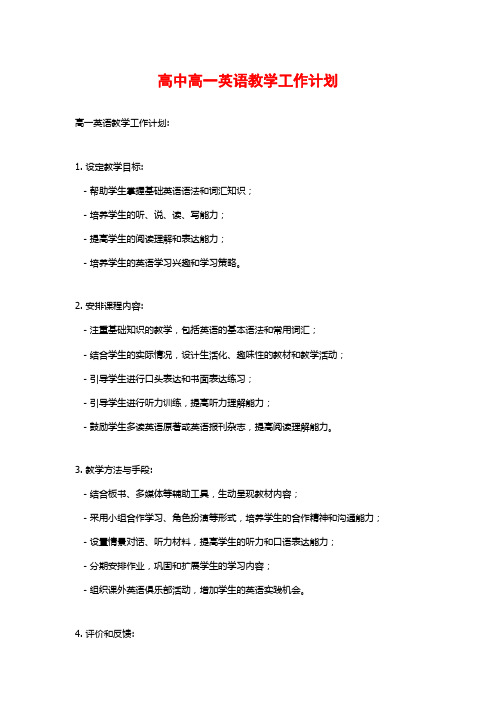
高中高一英语教学工作计划
高一英语教学工作计划:
1. 设定教学目标:
- 帮助学生掌握基础英语语法和词汇知识;
- 培养学生的听、说、读、写能力;
- 提高学生的阅读理解和表达能力;
- 培养学生的英语学习兴趣和学习策略。
2. 安排课程内容:
- 注重基础知识的教学,包括英语的基本语法和常用词汇;
- 结合学生的实际情况,设计生活化、趣味性的教材和教学活动;
- 引导学生进行口头表达和书面表达练习;
- 引导学生进行听力训练,提高听力理解能力;
- 鼓励学生多读英语原著或英语报刊杂志,提高阅读理解能力。
3. 教学方法与手段:
- 结合板书、多媒体等辅助工具,生动呈现教材内容;
- 采用小组合作学习、角色扮演等形式,培养学生的合作精神和沟通能力; - 设置情景对话、听力材料,提高学生的听力和口语表达能力;
- 分期安排作业,巩固和扩展学生的学习内容;
- 组织课外英语俱乐部活动,增加学生的英语实践机会。
4. 评价和反馈:
- 定期进行考试和测试,评估学生的英语水平;
- 注重对学生学习情况和进展的跟踪;
- 及时给予学生学习方法和学习策略上的指导;
- 组织口语比赛和写作比赛,激发学生学习的积极性。
5. 师生互动与沟通:
- 倾听学生的意见和建议,根据学生的需求和反馈,调整教学内容和方法;
- 鼓励学生进行英语交流和互助学习,营造良好的学习氛围;
- 组织学生参加英语角和英语竞赛,拓宽学生的英语学习渠道。
以上是高一英语教学工作的基本计划,具体实施中可以根据教材和学生的实际情况进行调整和完善。
- 1、下载文档前请自行甄别文档内容的完整性,平台不提供额外的编辑、内容补充、找答案等附加服务。
- 2、"仅部分预览"的文档,不可在线预览部分如存在完整性等问题,可反馈申请退款(可完整预览的文档不适用该条件!)。
- 3、如文档侵犯您的权益,请联系客服反馈,我们会尽快为您处理(人工客服工作时间:9:00-18:30)。
轮流做某事 开始 阻止/不使…做…
8. take sb on a tour of… 9. die out 10. live a better life
带领某人参观… 灭绝
生活得更好
11. take measures 12. for different reasons 13. be used to the environment
二、重点词组短语句型
Unit 10 1. know of/ about
第十单元 听说过,知道有(某人/某事)
2. in danger 3. lead to 4. act as
在危险中,病危 通向,导致 充当,担任
5. take turns doing sth 6. get started 7. keep…from…
注意要点: 1.熟悉这类检测题的设问形式。 2.确定听音时的听音重点。
3.抓住听音中的关键词或关键句。
五、写作:如何作一个海报(有关环境保护) 注意制作海报的基本要求、步骤和写作要点
六、重点词语、句型用法
(一)、重点词汇
1. fur n. 毛皮,毛,软毛(a hair-covered skin of certain animals; the soft thick fine hair that covers the bodies of some types of animals) a fur coat 皮大衣; a fine fox fur 一张好的狐皮。
减少环境污染 一大笔钱 一字一字地;逐字
34. up to 35. keep…as… 36. on the earth
多达…… 把……当作… 地球上
37. the total number of 38. traditional Chinese medicine 39. give sb advice on /about
28. go on a tour to… 29. be attractively packaged 30. be harmful to
去…参观/观光 包装精美
对…有害
31. reduce the pollution of the environment 32. a large amount of money 33. word for word
采取措施 由于不同的原因 习惯于这种环境
use…for… be used to do used to do
用……来…… ……被用来做…… 过去常常
14. adapt to the change 15. learn more about 16. create more space for
适应变化
对…了解得更多 为…开辟更多的空间
个人(to give or apply (ones time, attention, or self) entirely to a particular activity, pursuit, cause, or person.) He devoted all his time to his job. 他把他的全部时间都用在工作上了。 This magazine is devoted to science. 这个杂志专门刊载科技文章。 After he has retired, he will devote himself to gardening. 退休后,他将要致力于园艺。 Everybody knows that our director is very devoted to his wife.人人都知道我们的厂长对妻子十 分忠诚。
字对字 每年消失的物种
假如不采取措施的话
在农场 熊制药品
过去有…… 看起来像…… 既然……
三、语法:复习直接引语与间接引语 将直接引语改为间接引语的方法:
1. 注意人称:一变三,三不变;二变一,看宾语 2、语序:无论什么句做间接引语都用陈述句语序 3、引导词:陈述句用 that 引导;一般疑问句用 if / whether 引导;特殊疑问句用特殊疑问词 引导;祈使句改为 ask / tell sb. to do sth 4、时态:主句为一般现在时,从句用任何时态;主句为一般过去时,从句用相 应的过去时态
vt, vi 量;测量;计量( to find the size, length, amount, degree, etc) Mother measured me to see what size of dress I should have.母亲给我量尺寸,好知道我该穿多大 号的衣服。 I measured the coat against her and found it was too long. 我把外衣在她身上量了一下,发觉太长 了 8. original adj.最初的;最早的;原始的 (first or earliest) Who was the original owner of this house? 谁是这座房子最早的主人? The original owner of the house was the Duke of Wellington.这房子本来的主人是威灵顿公爵。 This is the original painting, and these others are copies. 这画是原作,其他的是复制品。 9. battery n. 电池 (a piece of apparatus for producing electricity, consisting of a group of connected electric cells) Our bus wont start because the battery is flat.我们的大客车发动不起来了,因为电池坏了。 10. devote vt. 奉献将(某人的时间、精力或自己)完全奉献给某项特别的活动、事业、目标或 某
注意:1)小品词的变化:For example: now→then ; yesterday → that day ect 2)但从句表示的是客观真理或客观事实时,主句用一般过去时,从句仍用一般现在
时。 四、听力:如何更好地理解以原因或理由为检测点的简短对话
常见句型:Why does/did sb do sth? What reason was …for ?
总数 中药 就…给某人提建议
40. ask for 41. cut down 42. no longer
要求,要…,点… 砍伐; 削减 不再
43. There is /are…left. 44. where he laid the book,…
还剩下…… 在放书的地方,……
45. make sure 46. find out 47. take good care of… 48. before it is too late 49. that is, 50. first of all 51. pick up 52. do what he can to save… 53. thank you for having helped me 54. many answers to the question 55. care about the environment 56. be much better at doing … 57. instead of… 58. survival of the fittest 59. be worried about… 60. in the past 61. have an effect on… 62. such as 63. key pal 64. spend … doing / on sth. 65. as … as possible 66. prefer … to … 67. make noises 68. catch a cold 69. the day before 70. word for word 71. species lost each year 72. If nothing is done,… 73. on farms 74. medicine made from the bears 75. there used to be… 76. look like 77. now that
2. jungle n. 热带丛林(a tropical forest too thick to walk through easily) jungle animals 丛林动物;the jungle of business 错综复杂的商业界
3. wolf n. 狼(a wild animal of the dog family which hunts other animals in a group) a wolf in sheep’s clothing 披着羊皮的狼
7. measure n. 1) 计量单位 (unit, standard or system used in stating size, quantity, or degree; step) A meter is
a measure of length. 2) 措施;办法
They took strong measures against dangerous drivers. 他们对危害公众的司机采取强硬的措 施。务必源自 确保; 保证 发现; 查明 精心照顾
乘还不太晚
也就是说, 首先
捡起; 用车接人 尽全力去救 谢谢你帮了我
许多这个问题的答案
关心环境 更善长做…… 取代; 不是…… 适者生存 担心…… 过去
对……产生影响 像……; 比如…… 网友
花费……做…… 尽可能…… 情愿……而不愿…… 吵闹 得感冒
前天
17. make a big difference make no difference
18. devote…to…
有很大影响/关系 没有区别, 没关系 献身于…专论于…
